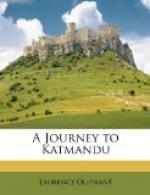However that may be, there is no doubt of the existence of these mines, and, if ever there were tolerable roads, the necessary skill for working them would doubtless follow. So backward are the Nepaulese in their treatment of minerals, that they cannot smelt lead: the fact of their beating cannon-balls into shape proves their incapacity to cast iron, unless it results from a peculiarity of the ore, so frequent in India, which, instead of yielding cast-iron at once when reduced in the usual way, gives wootz—a condition of iron closely allied to steel, ductile but not fusible. Of this I had no opportunity of judging.
Nepaul also possesses mines of sulphur, and, it is said, of antimony; whether this latter is found in the country does not seem certain; it is, however, an article of import from Thibet. Amongst other minerals are corundum, figure-stone, and talc; and amongst the present exports from the interior of Nepaul may be noticed turmeric, wax, honey, resin, pepper, cardamums: all these, however, are exported in but small quantities, owing partly to the difficulty of transport, and partly to the want of enterprise and capital in a nation thoroughly ignorant of all mercantile transactions.
It is much to be regretted that no European is now allowed to settle in Nepaul; for its many latent resources must remain undiscovered, or at least undeveloped, until the present blind policy of its government is changed, when British enterprise and British capital introduces a new era in its commercial existence, which will doubtless prove no less profitable to the country itself than to the capitalist.
Of the immense expanse of country lying in a north-westerly direction towards Cashmere we know nothing, save by report, and that is not always to be trusted. The Minister told me that, in a province three days’ journey from the capital in that direction, sufficient horses were bred to supply the wants of the whole country. That seemed perfectly possible, considering how limited is the demand in this respect; but, on our homeward journey, we passed a drove of upwards of two hundred long-backed, spindle-legged colts, going up to Katmandu, and that did not seem exactly corroborative of the Minister’s assertion.
But, whatever may be its capabilities as regards horses, it doubtless possesses many resources; but it is not on the productions of Nepaul alone that the European speculator would calculate, but on the rare and precious merchandise of Thibet and the northern provinces of China—such as the miledo, or exquisitely soft material fabricated from the wool of the celebrated shawl-goat, itself a rare and valuable animal; and the chowries or tails of a peculiar species of bullock inhabiting the snowy regions, at present an article of export from the hill states in the north-west provinces of India, and extensively used throughout the continent as fly-flappers.




